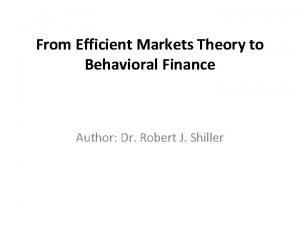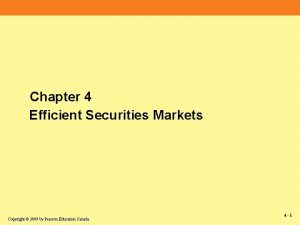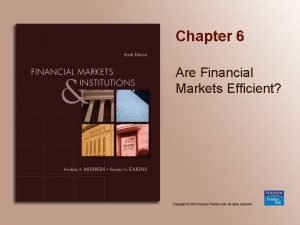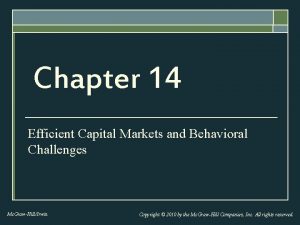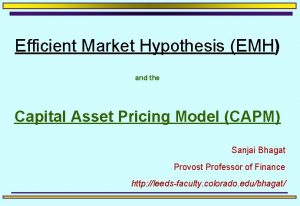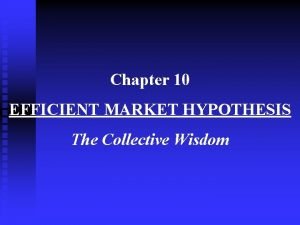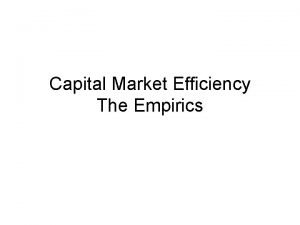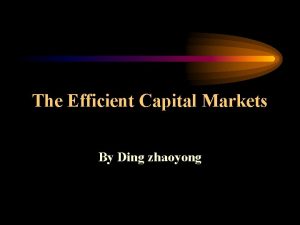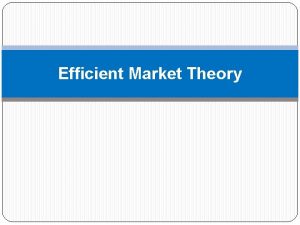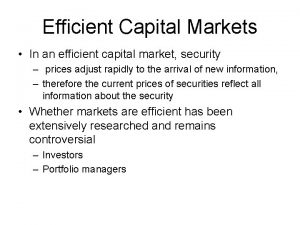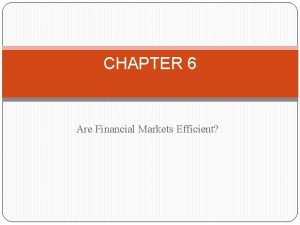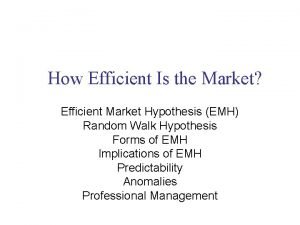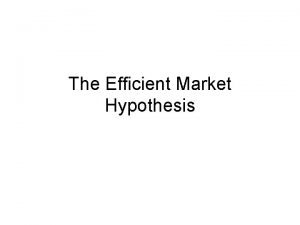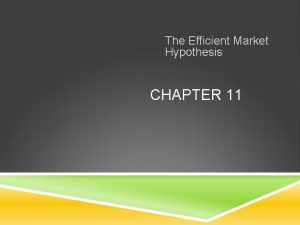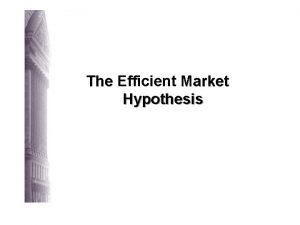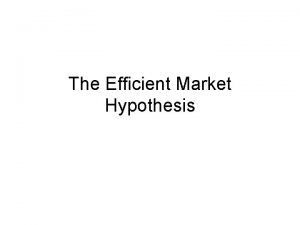Efficient Market Theory Efficient Markets In an efficient

























- Slides: 25

Efficient Market Theory

Efficient Markets • In an efficient stock market, the price for any given stock effectively represents the expected net present value of all future profits • Interplay of supply and demand sets prices • Price for any stock or bond represents collective wisdom about future prospects

Efficient Markets Hypothesis • EMH holds that security prices fully reflect all available information at any time. • Individual and professional investors buy and sell stocks under assumption that intrinsic value differs from market price. • Perfectly competitive securities market: – New information arrives at market independently and randomly. – Both buyers and sellers adjust rapidly to new info. – Current security prices reflect all relevant risk/return info.

The EMH Graphically All historical prices and returns • In this diagram, the circles represent the amount of information that each form of the EMH includes. • Note that the weak form covers the least amount of information, and the strong form covers all information. • Also note that each successive form includes the previous ones. All information, public and private All public information

Levels of Market Efficiency • Weak-Form Hypothesis: current prices reflect all stock market information; trading rules based on past stock market return or volume are futile. • Semistrong-Form Hypothesis: current prices reflect all public information; trading rules based on public information are futile. • Strong-Form Hypothesis: current prices reflect all public information and non-public information. All trading rules are futile.

Public vs. Private Information • Stock Market Information: stock price and trading volume figures • Public Information: freely shared information • Nonpublic Information: proprietary data • Insider Information: proprietary information within a firm

Time Series of Stock Prices • Time Series: date points over time • Correlation among stock indexes is strong. • Daily Returns: stock prices change irregularly • Daily returns are noisy (highly variable) and random around a mean of zero • Distribution of daily returns is normal; follows bell-shaped curve • Booms and Busts: reversion to the mean in day-to-day trading doesn’t work

Random Walk Theory • Random Walk: irregular pattern of numbers that defies prediction • Random Walk Theory: concept that stock price movements do not follow any pattern or trend • Fair Game: even bet; 50 -50 chance • Random Walk With Drift: slight upward bias to inherently unpredictable daily stock prices DJIA Prices

Figure 12. 4 Random Walk Research Evidence supports notion of random walk

Tests of the Weak Form • • • Serial correlations. Runs tests. Filter rules. Relative strength tests. Many studies have been done, and nearly all support weak form efficiency, though there have been a few anomalous results.

Serial Correlations • The following chart shows the relationship (there is none) between S&P 500 returns each month and the returns from the previous month. Data are from Feb. 1950 to Sept. 2001. • Note that the R 2 is virtually 0 which means that knowing last month’s return does you no good in predicting this month’s return. • Also, notice that the trend line is virtually flat (slope = 0. 008207, t-statistic = 0. 2029, not even close to significant) • The correlation coefficient for this data set is 0. 82%

Serial Correlations (cont. )

Filter Rule • If a price of a security rises by X percent the investor will buy and hold the security, till the price of the security is decline by X percentage. • Short sellers uses this concept

Run Test • Used to find out whether the series of price movements is occurred by chance • E. g. Tossing a coin- HH TT • Run Test Z= R-X/ σ R- number of runs X- (2 n 1 n 2/ n 1+n 2) +1 σ- standard deviation

The Semi-strong Form • The semi-strong form says that prices fully reflect all publicly available information and expectations about the future. • This suggests that prices adjust very rapidly to new information, and that old information cannot be used to earn superior returns. • The semi-strong form, if correct, repudiates fundamental analysis. • Most studies find that the markets are reasonably efficient in this sense, but the evidence is somewhat mixed.

• Simple Regression Technique r it= ά 1+β 1. rmt+ eit Where rit-v realized return of I stock for time period t rmt- realized return for index in time period t ά 1+β 1 - regression coefficients eit- error term

The Strong Form • The strong form says that prices fully reflect all information, whether publicly available or not. • Even the knowledge of material, non-public information cannot be used to earn superior results. • Most studies have found that the markets are not efficient in this sense.

Tests of the Strong Form Corporate Insiders. Specialists. Mutual Funds. Studies have shown that insiders and specialists often earn excessive profits, but mutual funds (and other professionally managed funds) do not. • In fact, in most years, around 85% of all mutual funds underperform the market. • •

Anomalies • Anomalies are unexplained empirical results that contradict the EMH: – The Size effect. – The “Incredible” January Effect. – P/E Effect. – Day of the Week (Monday Effect).

The Size Effect • Beginning in the early 1980’s a number of studies found that the stocks of small firms typically outperform (on a risk-adjusted basis) the stocks of large firms. • This is even true among the largecapitalization stocks within the S&P 500. The smaller (but still large) stocks tend to outperform the really large ones.

The “Incredible” January Effect • Stock returns appear to be higher in January than in other months of the year. • This may be related to the size effect since it is mostly small firms that outperform in January. • It may also be related to end of year tax selling.

The P/E Effect • It has been found that portfolios of “low P/E” stocks generally outperform portfolios of “high P/E” stocks. • This may be related to the size effect since there is a high correlation between the stock price and the P/E. • It may be that buying low P/E stocks is essentially the same as buying small company stocks.

The Day of the Week Effect • Based on daily stock prices from 1963 to 1985 Keim found that returns are higher on Fridays and lower on Mondays than should be expected. • This is partly due to the fact that Monday returns actually reflect the entire Friday close to Monday close time period (weekend plus Monday), rather than just one day. • Moreover, after the stock market crash in 1987, this effect disappeared completely and Monday became the best performing day of the week between 1989 and 1998.

Summary of Tests of the EMH • Weak form is supported, so technical analysis cannot consistently outperform the market. • Semi-strong form is mostly supported , so fundamental analysis cannot consistently outperform the market. • Strong form is generally not supported. If you have secret (“insider”) information, you CAN use it to earn excess returns on a consistent basis. • Ultimately, most believe that the market is very efficient, though not perfectly efficient. It is unlikely that any system of analysis could consistently and significantly beat the market (adjusted for costs and risk) over the long run.

 From efficient markets theory to behavioral finance
From efficient markets theory to behavioral finance Efficient market hypothesis
Efficient market hypothesis How would you define efficient security markets
How would you define efficient security markets Are financial markets efficient
Are financial markets efficient Efficient capital markets and behavioral challenges
Efficient capital markets and behavioral challenges Efficient capital markets ii
Efficient capital markets ii Leader follower challenger nicher
Leader follower challenger nicher Targeting positioning segmentation
Targeting positioning segmentation Productively efficient vs allocatively efficient
Productively efficient vs allocatively efficient Productively efficient vs allocatively efficient
Productively efficient vs allocatively efficient Productively efficient vs allocatively efficient
Productively efficient vs allocatively efficient Allocative efficiency vs productive efficiency
Allocative efficiency vs productive efficiency Productively efficient vs allocatively efficient
Productively efficient vs allocatively efficient Evidence supporting efficient market hypothesis
Evidence supporting efficient market hypothesis Efficient market hypothesis
Efficient market hypothesis Efficient market hypothesis.
Efficient market hypothesis. The following are advantages of the sml approach
The following are advantages of the sml approach The efficient market hypothesis suggests that _______.
The efficient market hypothesis suggests that _______. Characteristics of an efficient market
Characteristics of an efficient market An efficient capital market is one in which
An efficient capital market is one in which An efficient capital market is one in which
An efficient capital market is one in which Teaching market structures with a competitive gum market
Teaching market structures with a competitive gum market Forms of poultry
Forms of poultry Primary target market and secondary target market
Primary target market and secondary target market Decision making units
Decision making units Real estate space market
Real estate space market
